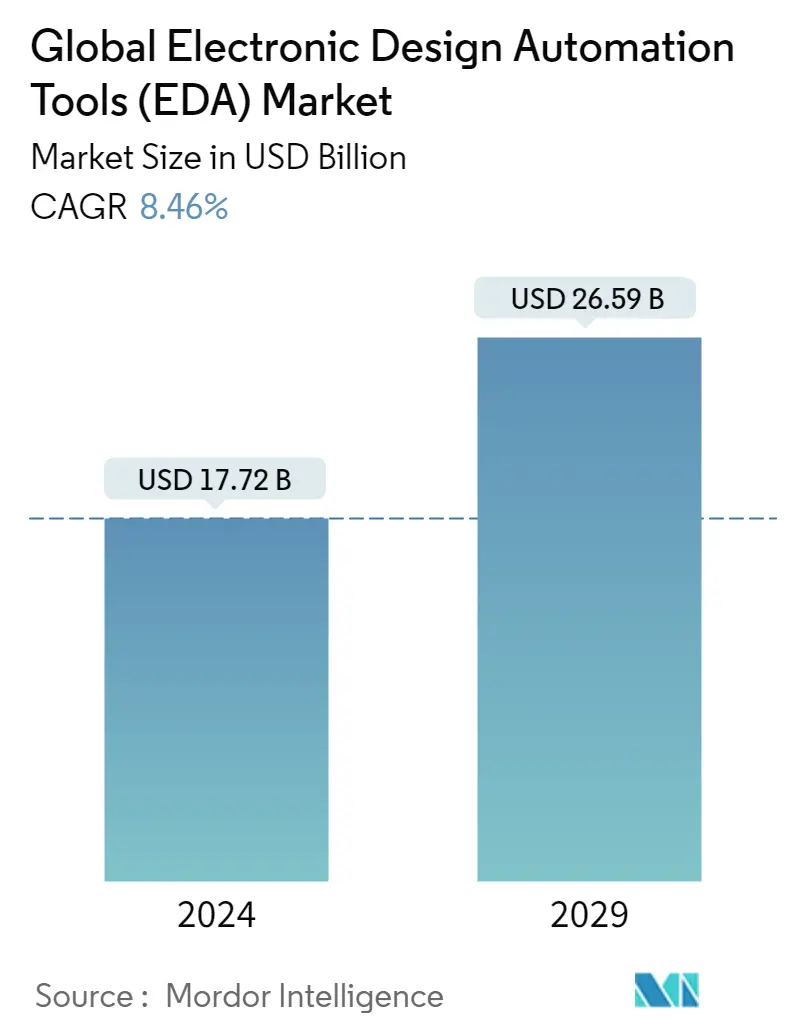Market Size of Global Electronic Design Automation Tools (EDA) Industry

| Study Period | 2019 - 2029 |
| Market Size (2024) | USD 17.72 Billion |
| Market Size (2029) | USD 26.59 Billion |
| CAGR (2024 - 2029) | 8.46 % |
| Fastest Growing Market | Asia-Pacific |
| Largest Market | Asia-Pacific |
| Market Concentration | Low |
Major Players
*Disclaimer: Major Players sorted in no particular order |
EDA Tools Market Analysis
The Global Electronic Design Automation Tools Market size is estimated at USD 17.72 billion in 2024, and is expected to reach USD 26.59 billion by 2029, growing at a CAGR of 8.46% during the forecast period (2024-2029).
The main factors propelling the market's expansion are the growing need for compact electronic devices and the expanding use of SoC technology across various industries, including automotive, IoT, and AI.
- The silicon sector has evolved in recent years because of electronic design automation (EDA) techniques. EDA is responsible for creating the design tools necessary for the IC design process at a cost that enables the ecosystem to run profitably.
- Some of the benefits of using EDA tools include reducing the amount of time needed to develop complicated ICs, cutting manufacturing costs, eliminating manufacturing defects, improving IC design and ease of use, etc.
- According to World Semiconductor Trade Statistics (WSTS), the semiconductor industry is expected to grow by 10.9% in 2021, which is a significant growth compared to the previous year's growth, approximately amounting to USD 488 billion. Owing to this, various semiconductor vendors are expected to increase their R&D budgets. For instance, in April 2021, Taiwan Semiconductor Manufacturing Corporation ( TSMC) announced to spend USD 100 billion over the next three years to expand its chip fabrication capacity and R&D.
- Chipmakers are increasingly leaning toward incorporating AI on edge computing, owing to the computational capabilities it brings to the table at the device level, increasing both efficiency and response time. For instance, Intel is focusing on 'edge computing' to enable AI incorporation into IoT devices to smartphones.
- EDA has become more popular due to its many benefits, including shorter design times and fewer errors. EDA tools have become more widely used in various industries, including the automotive and aerospace industries. However, one of EDA's shortcomings lies in its inability to obtain insights from previous designs.
- Since the inception of semiconductors, Moore's Law-the prediction that the number of transistors in an integrated circuit will increase two-fold every 18-24 months-has held true. However, in recent years, scientists have increasingly come to believe that fundamental physical limits may soon make it hard to economically place additional elements on the same small area, which could ultimately prove that Moore's Law is faulty.
- Since the COVID-19 breakout, the semiconductor industry has been severely impacted, significantly impacting its supply chain and production facilities. In February and March 2020, China and Taiwan's production ceased, affecting other OEM production worldwide. However, a significant portion of important vendors stocked up on electronics in anticipation of the Chinese New Year, which reduced the risk. Additionally, with the semiconductor industry's slowing growth, the initial pandemic epidemic saw a minor decline in demand for EDA tools; but, over the course of a year, the market experienced growth.
EDA Tools Industry Segmentation
Electronic design automation (EDA) is a software product that helps in designing electronic systems with the aid of computers; these tools are often used to design circuit boards, processors, and different types of complex electronics. The software tool is also known as electronic computer-aided design, and it has largely replaced manual methods for designing circuit boards and semiconductors.
The Global Electronic Design Automation Tools (EDA) Market is segmented by Type (Computer-aided Engineering (CAE), IC Physical Design and Verification, Printed Circuit Board and Multi-chip Module (PCB and MCM), Semiconductor Intellectual Property (SIP), Services), by Application (Communication, Consumer Electronics, Automotive, Industrial), and by Geography.
| Type | |
| Computer-aided Engineering (CAE) | |
| IC Physical Design and Verification | |
| Printed Circuit Board and Multi-chip Module (PCB and MCM) | |
| Semiconductor Intellectual Property (SIP) | |
| Services |
| Application | |
| Communication | |
| Consumer Electronics | |
| Automotive | |
| Industrial | |
| Other Applications |
| Geography | |
| North America | |
| Europe | |
| Asia Pacific | |
| Rest of the World |
Global Electronic Design Automation Tools (EDA) Market Size Summary
The Electronic Design Automation (EDA) tools market is poised for significant growth, driven by the increasing demand for compact electronic devices and the widespread adoption of System on Chip (SoC) technology across sectors such as automotive, IoT, and AI. EDA tools play a crucial role in the semiconductor industry by streamlining the design process for integrated circuits (ICs), thereby reducing development time, lowering manufacturing costs, and minimizing defects. The market's expansion is further supported by advancements in silicon technology and the growing need for efficient design solutions in complex electronic systems. Despite challenges such as the impact of COVID-19 on the semiconductor supply chain, the market has shown resilience and is expected to continue its upward trajectory.
North America stands out as a key region for the EDA tools market, bolstered by the presence of major vendors and ongoing developments in the semiconductor and circuit manufacturing industries. Companies like Xilinx, Ansys, Keysight Technologies, Cadence Design Systems, and Synopsys are at the forefront, driving innovation and expanding their product offerings to meet the rising demand. The market is characterized by fragmentation, with numerous players capitalizing on opportunities in emerging sectors like AI, virtual/augmented reality, and mixed-signal chip design. Recent strategic acquisitions and technological advancements, such as cloud-based EDA solutions and machine learning optimization techniques, are enhancing design flexibility and efficiency, further propelling market growth.
Global Electronic Design Automation Tools (EDA) Market Size - Table of Contents
-
1. MARKET INSIGHTS
-
1.1 Market Overview
-
1.2 Industry Value Chain Analysis
-
1.3 Industry Attractiveness: Porter's Five Forces Analysis
-
1.3.1 Bargaining Power of Suppliers
-
1.3.2 Bargaining Power of Buyers
-
1.3.3 Threat of New Entrants
-
1.3.4 Intensity of Competitive Rivalry
-
1.3.5 Threat of Substitute Products
-
-
1.4 Assessment of the Impact of COVID-19 on the Industry
-
-
2. MARKET SEGMENTATION
-
2.1 Type
-
2.1.1 Computer-aided Engineering (CAE)
-
2.1.2 IC Physical Design and Verification
-
2.1.3 Printed Circuit Board and Multi-chip Module (PCB and MCM)
-
2.1.4 Semiconductor Intellectual Property (SIP)
-
2.1.5 Services
-
-
2.2 Application
-
2.2.1 Communication
-
2.2.2 Consumer Electronics
-
2.2.3 Automotive
-
2.2.4 Industrial
-
2.2.5 Other Applications
-
-
2.3 Geography
-
2.3.1 North America
-
2.3.2 Europe
-
2.3.3 Asia Pacific
-
2.3.4 Rest of the World
-
-
Global Electronic Design Automation Tools (EDA) Market Size FAQs
How big is the Global Electronic Design Automation Tools (EDA) Market?
The Global Electronic Design Automation Tools (EDA) Market size is expected to reach USD 17.72 billion in 2024 and grow at a CAGR of 8.46% to reach USD 26.59 billion by 2029.
What is the current Global Electronic Design Automation Tools (EDA) Market size?
In 2024, the Global Electronic Design Automation Tools (EDA) Market size is expected to reach USD 17.72 billion.

